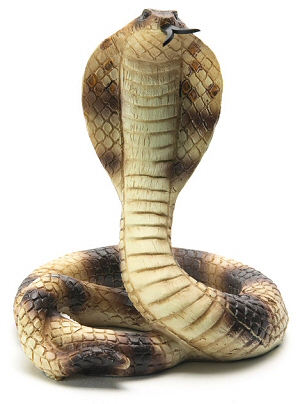Scientific Name: Naja haje
African Names: Egiptiese Kobra (Afrikaans), Bou-Ftira (Arabic), Bou Sekka (Arabic), Koboko (Swahili)
 Length: Normally between 5 and 8 feet long
Length: Normally between 5 and 8 feet long Average Adult Weight: Up to 20 pounds
Life Span: 20 to 30 years
Description: The cobra's head is large and depressed with a broad snout. Its eyes are large with round pupils. Most Egyptian cobras are a shade of brown with light or dark mottling. Often they have a "tear-drop" mark below their eye. Some Egyptian cobras are completely black.
Habitat: The cobra makes its home in areas that are dry to moist with some vegetation such as savanna and semi-desert areas. Egyptian cobras do not make their homes in desert areas.
Countries found in: Algeria, Benin, Burkina Faso, Cameroon, Central African Republic, Chad, Egypt, Eritrea, Ethiopia, Ghana, Guinea Bissau, Guinea, Ivory Coast, Kenya, Libya, Mali, Mauritania, Morocco, Niger, Nigeria, Senegal, Sierra Leone, Somalia, Sudan, Tanzania, Togo, and Uganda
Babies: Egyptian cobras lay 8 to 33 eggs in a clutch. The incubation period is anywhere from 48 to 70 days. The hatchlings are roughly 8 inches to 16.5 inches long. They are able to fend for themselves shortly after being hatched.
Food: Egyptian cobras like to eat eggs, chicks, toads, lizards, birds, small mammals, lizards, toads, along with other snakes.
Group Name: A quiver of cobras
Habits: In the wild, Egyptian cobras are nocturnal. You can occasionally see a cobra sunning itself in the early morning.
When threatened, the cobra will try to get away. If the cobra can't get away, it will rise up and spread its hood as a warning. Sometimes, they will pretend to convulse and die hoping predators will leave it alone.
Conservation Status: Least concern
Predators: Mongoose
Interesting Facts: The Egyptian cobra is one of the largest and most common cobras in Africa.
The venom from an Egyptian Cobra can kill an elephant in three hours and a human in fifteen minutes. The venom is a neurotoxin which stops signals from the nervous system from reaching muscles, lungs, and heart. Death is caused by complete respiratory failure.
Cleopatra, along with her two attendants, are said to have committed suicide by being bitten by an Egyptian cobra.
On March 25, 2011 an Egyptian cobra escaped from it's enclosure in the reptile house. The reptile house has been closed hoping the cobra will eventually emerge from its hiding place.


